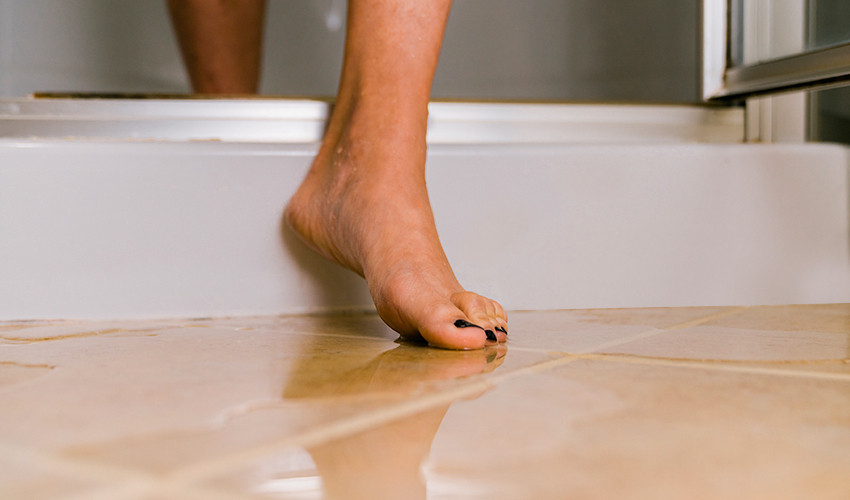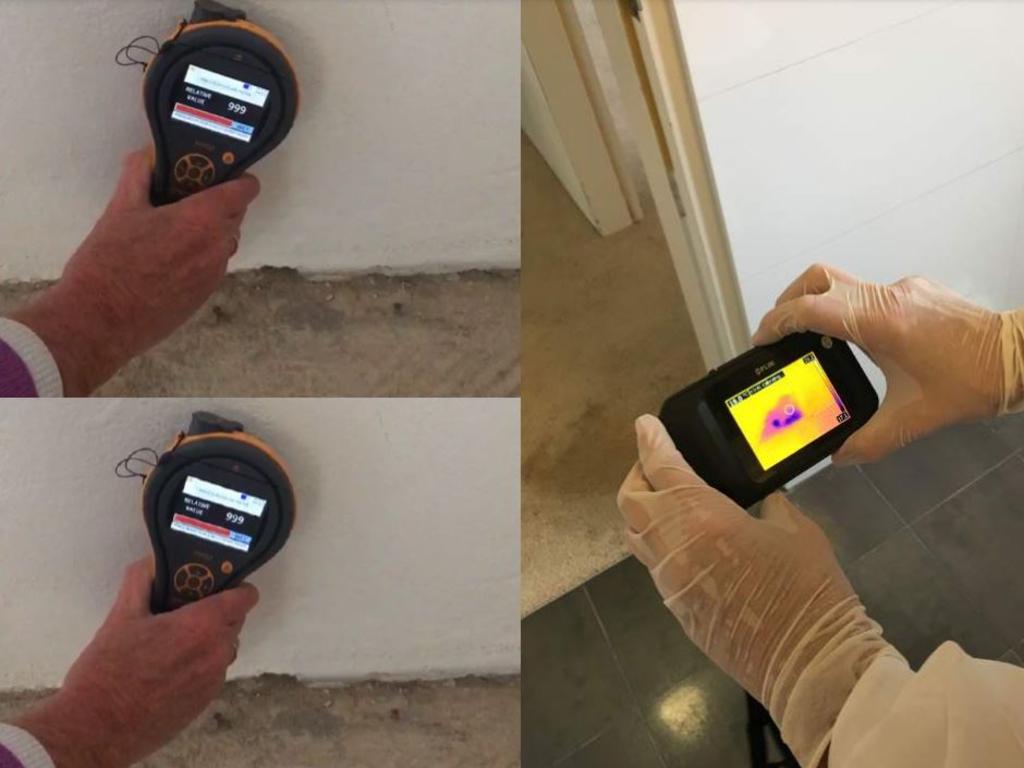Common household issue leaves one ‘perfectly healthy’ woman with dementia
- Replies 4
As the wet weather plagued the country in recent months, millions of residents came to realise how easily one unwanted visitor can show up in their homes – and how difficult getting rid of it is.
We all know that mould poses a risk to our health as it can trigger respiratory infections and escalate allergies… But for certain people, this common household problem results in a dreaded syndrome.
Amie Skilton is one of the 25 per cent of the population that has a genetic vulnerability to mould toxins. This means that mere exposure to mould can set off a serious inflammatory response in her body that can lead to grave consequences.
However, Amie only found out about her unique condition five years ago after suffering a horrific experience while living in her previous, mouldy apartment. Amie was 37 when she moved into the apartment with her now-husband.

Amie was ‘perfectly healthy’ before moving in. Source: news.com.au
She was ‘perfectly healthy’ back then and living an on-the-go lifestyle. She completed a 9-kilometre fun run, had been on a trip from the US twice to speak at two conferences, and delivered 39 keynote addresses before moving in.
‘My brain was fine and my body was fine,’ Amie, who works as a naturopath and nutritionist, recalled.
That was until the waterproofing in their shower was damaged during a recent renovation. As a result, water leaked under the carpet and across the apartment every time the shower was used.
‘I started getting sick, noticeably sick, about two months in.’ she explained.
‘It may have taken that long just because it happened during summer and was really sunny. We always had the windows open and we never registered that there was a leak at all.’
The hidden mould problem led to a ‘systematic breakdown’ of Amie’s body.
‘The first symptom that I noticed were allergies – chronic allergies. I also gained 10 kilos out of nowhere.’ she said.
‘I’m a nutritionist and have always been the same weight my whole life. I unexpectedly gained 10 kilos in only a few months and suffered from really bad fatigue.’
A few more months after, her cognitive state also started going downhill.
She struggled with work and was having trouble focusing. When her condition seemed far from improving, she was referred to a neurologist who diagnosed her with type three Alzheimer’s disease, also known as inhalational Alzheimer’s.

The waterproofing in Amie’s bathroom was damaged. Source: Mr Rooter Plumbing
As it progressed, little things such as leaving the house became arduous. She would forget where her keys were and after finding them an hour later, she would misplace her phone or another item.
‘Some days I couldn’t figure out how to get dressed. I would look at clothes and feel really confused about how to put them on.’ she said.
Amie also used to ride a Vespa but during one instance while she was out, she completely forgot where she parked. When she finally found her bike, she realised that she accidentally left the keys in the ignition.
However, the most terrifying symptom she had to date was when she couldn’t remember her own name.
‘I was filling out a form one day and I was staring at the box that said my name and I was like what is it again? I was staring at it, searching for it.’ she said, describing the pure horror of forgetting something so ‘deeply personal’.
Because she and her doctors were unaware of the mould problem in her house at the time, all of the tests she underwent weren’t detecting anything.
She said not many health professionals are savvy with mould-related afflictions, meaning that most people end up being diagnosed with chronic fatigue syndrome or fibromyalgia because they have similar symptoms.

Amie was having a hard time focusing. Source: Unsplash
‘This is exactly what happened. Everything came back fine, white blood cell counts fine, red blood cell counts were fine,’ Ms Skilton said, adding that most doctors brushed her off and reassured her that there was nothing wrong with her.
She started realising that something was really wrong in February 2017 and by May, the penny had dropped.
Amie stumbled across an online post shared by one of her friends, explaining how her husband possessed the mould gene. Her friend added that they just found a leak in their apartment that had been causing mould and impacting his health.
This prompted her to get their apartment assessed by a building biologist, who then mapped out the leak and discovered that water had gone under the carpet and into their bedroom and study.

They discovered mould growing everywhere! Source: news.com.au
‘The carpet looked totally fine on top but when she lifted it there was all this black mould. When we finally stripped back our mattress cover the mattress was green.’ she said.
After the horrific discovery, Amie was able to get the right things tested, which are specific inflammatory markers and a particular group of genes encoded by something called ‘the human leukocyte antigen’.
Once she got the test results back, she said: ‘It was 100 per cent clear that, not only was the place leaky and mouldy, but my immune system had reacted in the way we know my genetics would dictate in the face of mould.’
Five years later, Amie has fully recovered from the illness and is now living in a new place in NSW. She claims that her energy was back and that she is no longer suffering from any of the terrible symptoms. She is now a qualified mould testing technician and uses her knowledge to spread awareness.
The 42-year-old revealed one of her clients had such a horrific reaction to mould exposure over a number of years that she fell into a coma for three years.
Amie detailed that there are two ways to determine if you have a mould infestation in your home that is impacting your health.
‘You can either get a building biologist to check your home or a certified mould testing technician. All building biologists have done that training but not all mould testing technicians have gone on to do the rest of the building biology stuff.’ she explained.

If you’re experiencing similar symptoms, get tested. Source: Unsplash
You can also be tested to see if you have the gene that makes you susceptible to mould exposure, which can typically cost around $100 to $150, depending on the lab.
‘If you’re going to see a GP, you would want to see one who is an integrative GP or practices functional medicine.’ Ms Skilton said.
While some mould cases may vary, there are a couple of things you can do to stay on top of mould growth in your home.
Beaumont Tiles’ Manager for Adhesive and Tools, Trevor Grindley, said keeping silicone in the bathroom promotes mould growth, saying: ‘This can spread into the grout lines, particularly in wet areas like the shower due to grout’s porous composition.’
‘If epoxy grout hasn’t been used, most grout lines won’t be able to resist mould or mildew without using an impregnating sealer. This provides deep and lasting protection with an invisible finish.’
‘Ensuring adequate ventilation is another way to fight mould.’ Mr Grindley continued.
‘If you have an exhaust fan or an open window in your bathroom, this can help to prevent mould growth in your bathroom.’
Mr Grindley said bathroom additions like underfloor heating can help fight mould as it takes away moisture.
What are your thoughts on Amie’s shocking condition? Do you know anyone suffering from a similar issue with mould? Let us know in the comments.
Learn more about the ‘mould illness’ by watching the video below:
Source: Laura’s Natural Life
We all know that mould poses a risk to our health as it can trigger respiratory infections and escalate allergies… But for certain people, this common household problem results in a dreaded syndrome.
Amie Skilton is one of the 25 per cent of the population that has a genetic vulnerability to mould toxins. This means that mere exposure to mould can set off a serious inflammatory response in her body that can lead to grave consequences.
However, Amie only found out about her unique condition five years ago after suffering a horrific experience while living in her previous, mouldy apartment. Amie was 37 when she moved into the apartment with her now-husband.
Amie was ‘perfectly healthy’ before moving in. Source: news.com.au
She was ‘perfectly healthy’ back then and living an on-the-go lifestyle. She completed a 9-kilometre fun run, had been on a trip from the US twice to speak at two conferences, and delivered 39 keynote addresses before moving in.
‘My brain was fine and my body was fine,’ Amie, who works as a naturopath and nutritionist, recalled.
That was until the waterproofing in their shower was damaged during a recent renovation. As a result, water leaked under the carpet and across the apartment every time the shower was used.
‘I started getting sick, noticeably sick, about two months in.’ she explained.
‘It may have taken that long just because it happened during summer and was really sunny. We always had the windows open and we never registered that there was a leak at all.’
The hidden mould problem led to a ‘systematic breakdown’ of Amie’s body.
‘The first symptom that I noticed were allergies – chronic allergies. I also gained 10 kilos out of nowhere.’ she said.
‘I’m a nutritionist and have always been the same weight my whole life. I unexpectedly gained 10 kilos in only a few months and suffered from really bad fatigue.’
A few more months after, her cognitive state also started going downhill.
She struggled with work and was having trouble focusing. When her condition seemed far from improving, she was referred to a neurologist who diagnosed her with type three Alzheimer’s disease, also known as inhalational Alzheimer’s.
The waterproofing in Amie’s bathroom was damaged. Source: Mr Rooter Plumbing
As it progressed, little things such as leaving the house became arduous. She would forget where her keys were and after finding them an hour later, she would misplace her phone or another item.
‘Some days I couldn’t figure out how to get dressed. I would look at clothes and feel really confused about how to put them on.’ she said.
Amie also used to ride a Vespa but during one instance while she was out, she completely forgot where she parked. When she finally found her bike, she realised that she accidentally left the keys in the ignition.
However, the most terrifying symptom she had to date was when she couldn’t remember her own name.
‘I was filling out a form one day and I was staring at the box that said my name and I was like what is it again? I was staring at it, searching for it.’ she said, describing the pure horror of forgetting something so ‘deeply personal’.
Because she and her doctors were unaware of the mould problem in her house at the time, all of the tests she underwent weren’t detecting anything.
She said not many health professionals are savvy with mould-related afflictions, meaning that most people end up being diagnosed with chronic fatigue syndrome or fibromyalgia because they have similar symptoms.
Amie was having a hard time focusing. Source: Unsplash
‘This is exactly what happened. Everything came back fine, white blood cell counts fine, red blood cell counts were fine,’ Ms Skilton said, adding that most doctors brushed her off and reassured her that there was nothing wrong with her.
She started realising that something was really wrong in February 2017 and by May, the penny had dropped.
Amie stumbled across an online post shared by one of her friends, explaining how her husband possessed the mould gene. Her friend added that they just found a leak in their apartment that had been causing mould and impacting his health.
This prompted her to get their apartment assessed by a building biologist, who then mapped out the leak and discovered that water had gone under the carpet and into their bedroom and study.
They discovered mould growing everywhere! Source: news.com.au
‘The carpet looked totally fine on top but when she lifted it there was all this black mould. When we finally stripped back our mattress cover the mattress was green.’ she said.
After the horrific discovery, Amie was able to get the right things tested, which are specific inflammatory markers and a particular group of genes encoded by something called ‘the human leukocyte antigen’.
Once she got the test results back, she said: ‘It was 100 per cent clear that, not only was the place leaky and mouldy, but my immune system had reacted in the way we know my genetics would dictate in the face of mould.’
Five years later, Amie has fully recovered from the illness and is now living in a new place in NSW. She claims that her energy was back and that she is no longer suffering from any of the terrible symptoms. She is now a qualified mould testing technician and uses her knowledge to spread awareness.
The 42-year-old revealed one of her clients had such a horrific reaction to mould exposure over a number of years that she fell into a coma for three years.
Amie detailed that there are two ways to determine if you have a mould infestation in your home that is impacting your health.
‘You can either get a building biologist to check your home or a certified mould testing technician. All building biologists have done that training but not all mould testing technicians have gone on to do the rest of the building biology stuff.’ she explained.
If you’re experiencing similar symptoms, get tested. Source: Unsplash
You can also be tested to see if you have the gene that makes you susceptible to mould exposure, which can typically cost around $100 to $150, depending on the lab.
‘If you’re going to see a GP, you would want to see one who is an integrative GP or practices functional medicine.’ Ms Skilton said.
While some mould cases may vary, there are a couple of things you can do to stay on top of mould growth in your home.
Beaumont Tiles’ Manager for Adhesive and Tools, Trevor Grindley, said keeping silicone in the bathroom promotes mould growth, saying: ‘This can spread into the grout lines, particularly in wet areas like the shower due to grout’s porous composition.’
‘If epoxy grout hasn’t been used, most grout lines won’t be able to resist mould or mildew without using an impregnating sealer. This provides deep and lasting protection with an invisible finish.’
‘Ensuring adequate ventilation is another way to fight mould.’ Mr Grindley continued.
‘If you have an exhaust fan or an open window in your bathroom, this can help to prevent mould growth in your bathroom.’
Mr Grindley said bathroom additions like underfloor heating can help fight mould as it takes away moisture.
What are your thoughts on Amie’s shocking condition? Do you know anyone suffering from a similar issue with mould? Let us know in the comments.
Learn more about the ‘mould illness’ by watching the video below:
Source: Laura’s Natural Life







